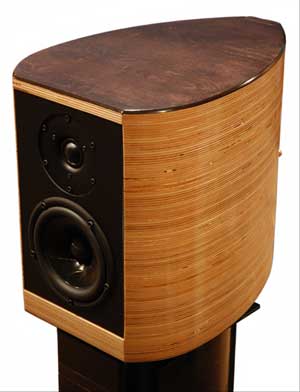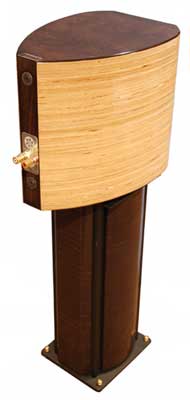Not
your average bookshelf speakers
by Ernie Fisher
 Back in April of 2008, I attended Montreal’s audio
fest (Festival De Son), and discovered the X1 loudspeakers
connected to an amplifier I had never seen or heard before.
However, I remembered the sound very well and when I received
a call from the company’s marketing people, I agreed
to take a serious look at the X1 speakers. Back in April of 2008, I attended Montreal’s audio
fest (Festival De Son), and discovered the X1 loudspeakers
connected to an amplifier I had never seen or heard before.
However, I remembered the sound very well and when I received
a call from the company’s marketing people, I agreed
to take a serious look at the X1 speakers.
Like other small manufacturers in the audio industry, Lafleuraudio
is a passion-driven group of audio lovers who decided to
enter the highly competitive loudspeaker market with their
first model, a superbly finished pair of bookshelf speakers.
The company claims to build “speakers differently
than other manufacturers” and, though this may be true,
I have seen similar designs in the past. However, there are
a number of small, but important elements that differ from
customary methods, and it begins with but is not restricted
to the enclosures’ construction. The design was conceived
by M. Emmanuel Lafleur who, with the assistance of other
dedicated audio enthusiasts planned and developed a robust
environment (the enclosure) for what was to become the X1.
It took a couple of years from concept to finished product — not
really an unusually long incubation period in the specialty
audio business.
Appearance
As indicated above, these loudspeakers are masterfully finished
and feature a unique oval shape. The cabinets’ contours
suggest that the designer knew a lot about avoiding resonance
and developing vibrations. The enclosures are made from
Russian cherry wood (hardwood) shaped with graceful curves
to avoid internal standing waves, but, I suspect, also
to add an elegant refinement to a necessary audio component.
Each speaker stands 17 inches high, 11 inches wide, 14
inches deep and weighs in at 42 pounds. Dedicated stands
are available and should be used, although any solid stand
filled with lead-shot will do.
The Sound
Every component in an audio system has a signature sound
making it important to find compatible components to ascertain
the best performance. Therefore, in order to find the best
possible mate, I used three amps, connected them to three
preamplifiers and used the Audio Aero Classic, the EAR
CD player as well as a turntable for source components.
For the first audition and the initial burn-in, I decided
on the powerful solid state Bryston 14B SST with the Modwright
preamp — two very compatible components. This system
combination sounded very impressive. The Bryston introduced
its smooth high frequency signature, making the X1s sound
very pleasant in the treble region, though I didn’t
particularly like the midrange — I found it to be a
bit too laid back. However, after a few days of operating
the system, midrange improved dramatically. My friend Sol
dropped in for an audition and gave the speakers the thumbs
up as the system’s sound advanced from quite good to
excitingly convincing — musically speaking.
 The next amp/preamp combination used for this evaluation
was the EAR push-pull tube amp with the matching preamp.
I was surprised to discover that this system didn’t
achieve the body and musical soul I heard with the Bryston/Modwright
combination. The highs were great, the midrange was smooth
and articulate and the bass was good to about 40Hz, but a
bit slow recovering from the woofers/ excursion pattern.
However, all this was still good audio and the only beef
I have regards the system’s inability to reproduce
peak dynamics. Yes, I’m nit picking. The next amp/preamp combination used for this evaluation
was the EAR push-pull tube amp with the matching preamp.
I was surprised to discover that this system didn’t
achieve the body and musical soul I heard with the Bryston/Modwright
combination. The highs were great, the midrange was smooth
and articulate and the bass was good to about 40Hz, but a
bit slow recovering from the woofers/ excursion pattern.
However, all this was still good audio and the only beef
I have regards the system’s inability to reproduce
peak dynamics. Yes, I’m nit picking.
The best electronics I have in-house are the Wyetech Lab
Ruby single-ended amps and matching preamp, a combination,
I assumed to be suitable for the X1s. Well, I was partially
right. Highs and midrange frequencies were not only smooth
and well balanced; the system also provided texture, detail,
ambience and space. Dynamics, the quality of wide dynamic
range, was in line with the nature of the signal (music)
and utterly realistic. Imaging, though good with all systems
was, well, out-of-the-box. Where it lacked was in the deep
bass regions — below 40Hz. In light of the speakers’ outstanding
performance in frequencies above 40Hz, I regard this the
slight deficiency the better alternative to booming bass.
40Hz is, after all, not essential to reproduce most musical
material.
Synopsis & Commentary
Some of the best-sounding components are made by people who
never make it into the conventional audio business. The
well-known brands, such as Panasonic, Sony, Pioneer in
the mass-market segment and Bryston, Krell or VTL in the
higher-end, enjoy recognition, having had advertising money
and history. However, a newcomer with talent often works
on a tight budget, but invests every bit as much time and
effort to finish a project; and he/she has to come up with
greater designs than the more prominent manufacturers.
Lafleur Audio is one of these manufacturers and the X1s
are the proof. They are designed with care and constructed
with attention to detail; but most of all, they are made
to reproduce music without adding a hint of colouration.
Connected to three potentially superb system combinations,
the X1s sounded great with varying degrees of achievement.
The combination that suits you best is the one to use, but
my own top pick would be the Bryston amp, Modwright preamp
combo. This, dear reader, is my opinion and is based on my
belief that synergy is a more important issue than price.
However, all it takes are ears — your ears — and
listen carefully using your existing system. If the speakers
sound right, you have compatibility — it’s a
simple as that. The X1s are not your average bookshelf speakers,
they are a work of art and some of the very few I could live
with.
|
